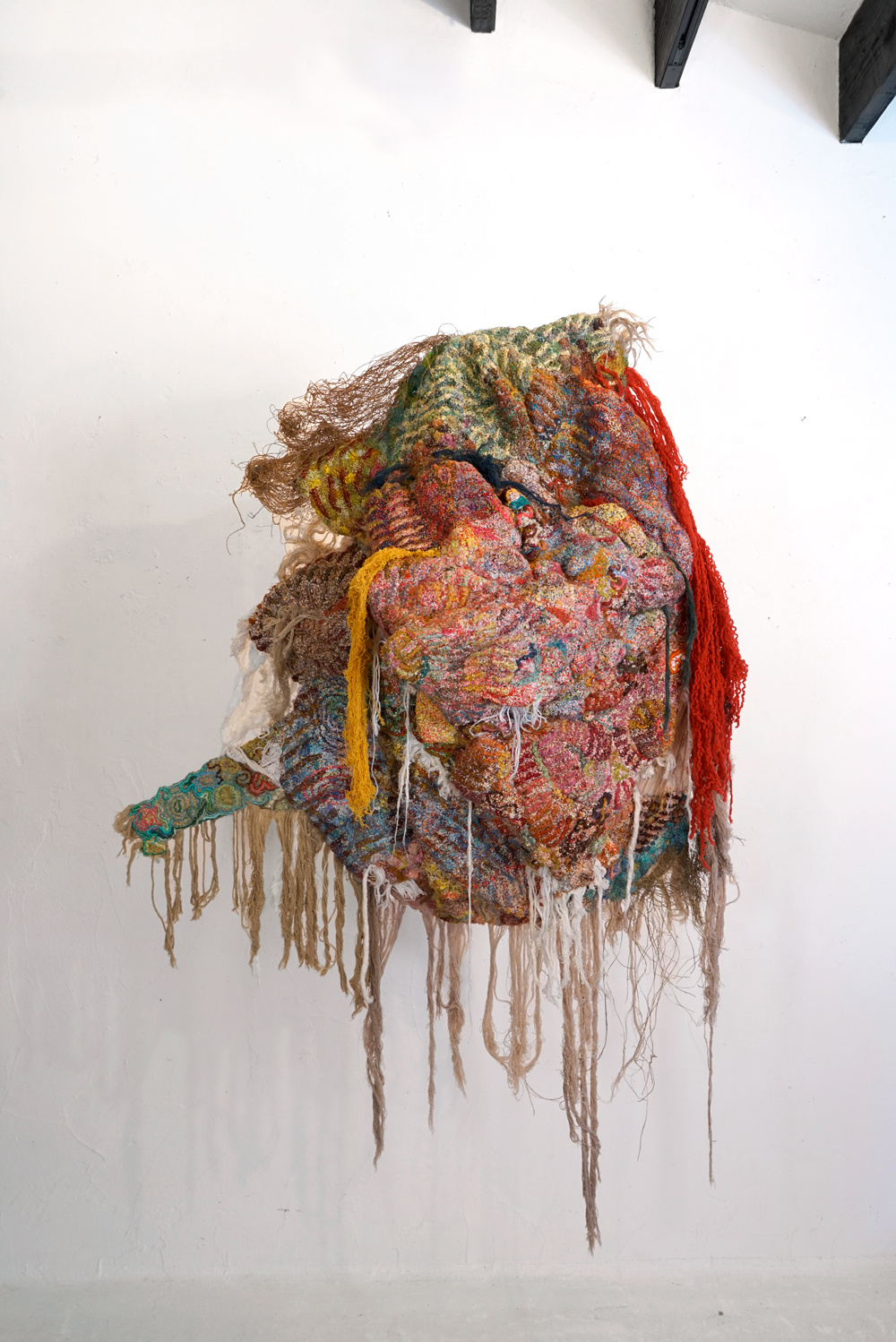かねてよりご案内しておりました伏木庸平 個展「Inner Light」は都合により中止となりました。
次回展覧会は、4月27日より「エスニックアートと伏木庸平のThread Sculpture」を開催いたしましす。
何卒ご理解のほどお願い申し上げます。
We regret to inform you that the exhibition ‘Yohei Fusegi – Inner Light – ‘ has been cancelled.
Please feel free to contact us for any questions you may have.
We are going to present the exhibition “World tribal art and Yohei FUSEGI’s thread sculpture” from 27th April.
please look forward to it. >>>next exhibition
Thank you so much for your understanding.
Yohei FUSEGI [1985 – ]
Based in Tokyo, Japan.
Solo Show
“My own god” Circle gallery&books, Tokyo 2017
“Vortex to be born” Shoshi-Gyakko, Tokyo 2016
“ké” Circle gallery&books, Tokyo 2015
Group Show
“Continuous Contours” Sezon Museum of Modern Art, Karuizawa 2022
“Kunitachi Art Center 2021” Koizumi-dougu-ten, Tokyo 2021
“Kunitachi Art Center 2020” YUKAKU, Tokyo 2020
“LOVE LOVE LOVE LOVE exhibition Pre-Event” Tokyo Midtown 2019
“Dan Miller – Thomas Machcinski – Yohei Fusegi” Espace art absolument, Paris 2018
“TANAKA Chuzaburo: Spirit of Life in the North of Japan” Towada Art Center, Aomori 2014-2015
“POCORART Declares” 3331 Arts Chiyoda, Tokyo / Museum of Art WARAKOH, Kochi / Odate Jukai Gymnasium, Akita 2014
“TRANS ARTS TOKYO” former Tokyo Denki University 2012
Collection
Sezon Museum of Modern Art
Prize
“Art Absolument Prize for Outsider Art – 2nd Edition” Outsider Art Fair Paris 2018
“POCORART vol.3 Mayor of Chiyoda Prize” 2013
高解像度の作品画像は>>>Artsyでご覧頂けます。
Details and hires images are available on >>>Artsy
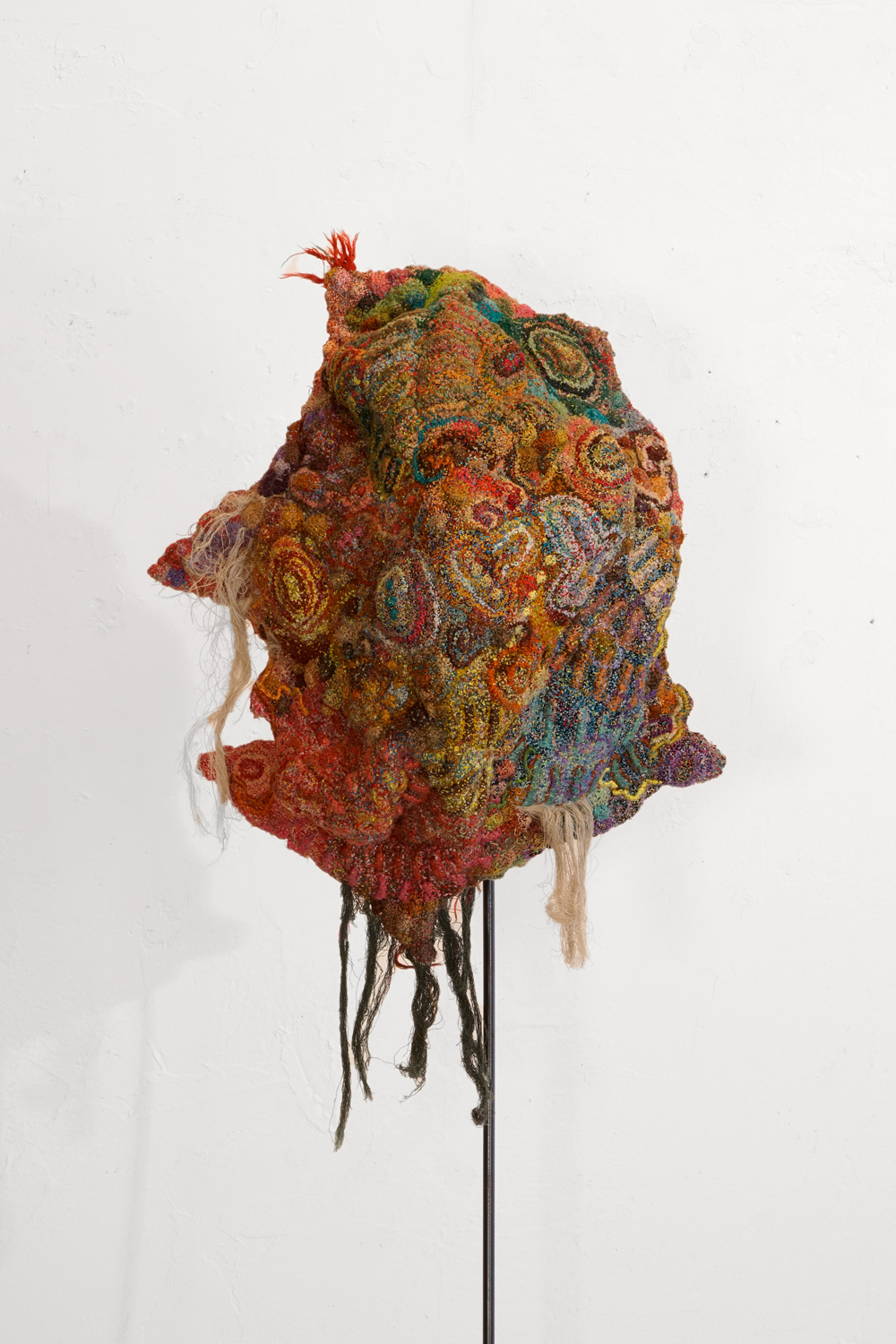
J
2023年
糸、布、鉄、石 | Thread, Cloth, Iron, Stone
50 × 37 × 17 cm (スタンド含む高さ:168cm)
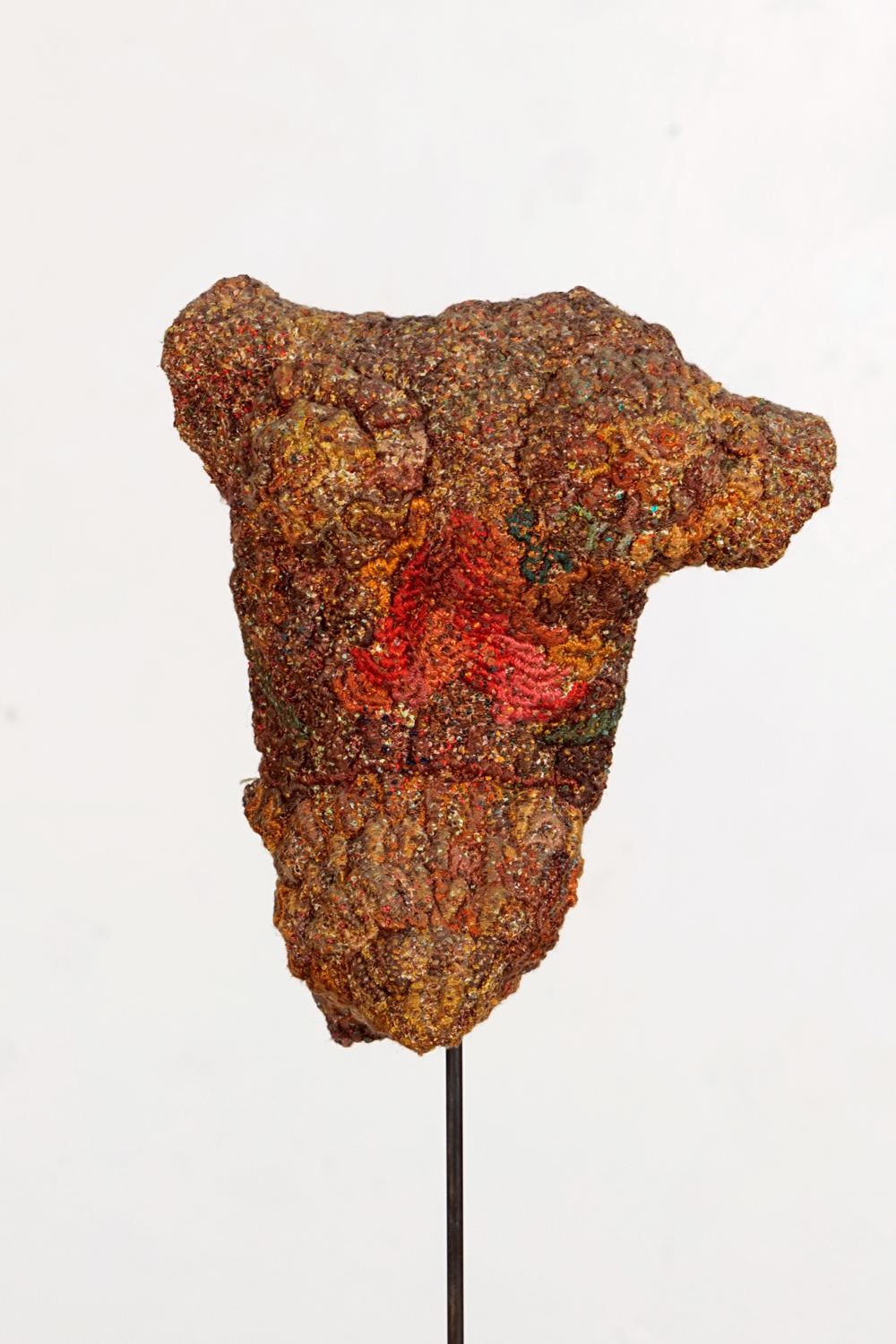
Unnamed 2015-1
2015年
糸、布、鉄、石 | Thread, Cloth, Iron, Stone
18 × 16 × 9 cm (スタンド含む高さ:143cm)
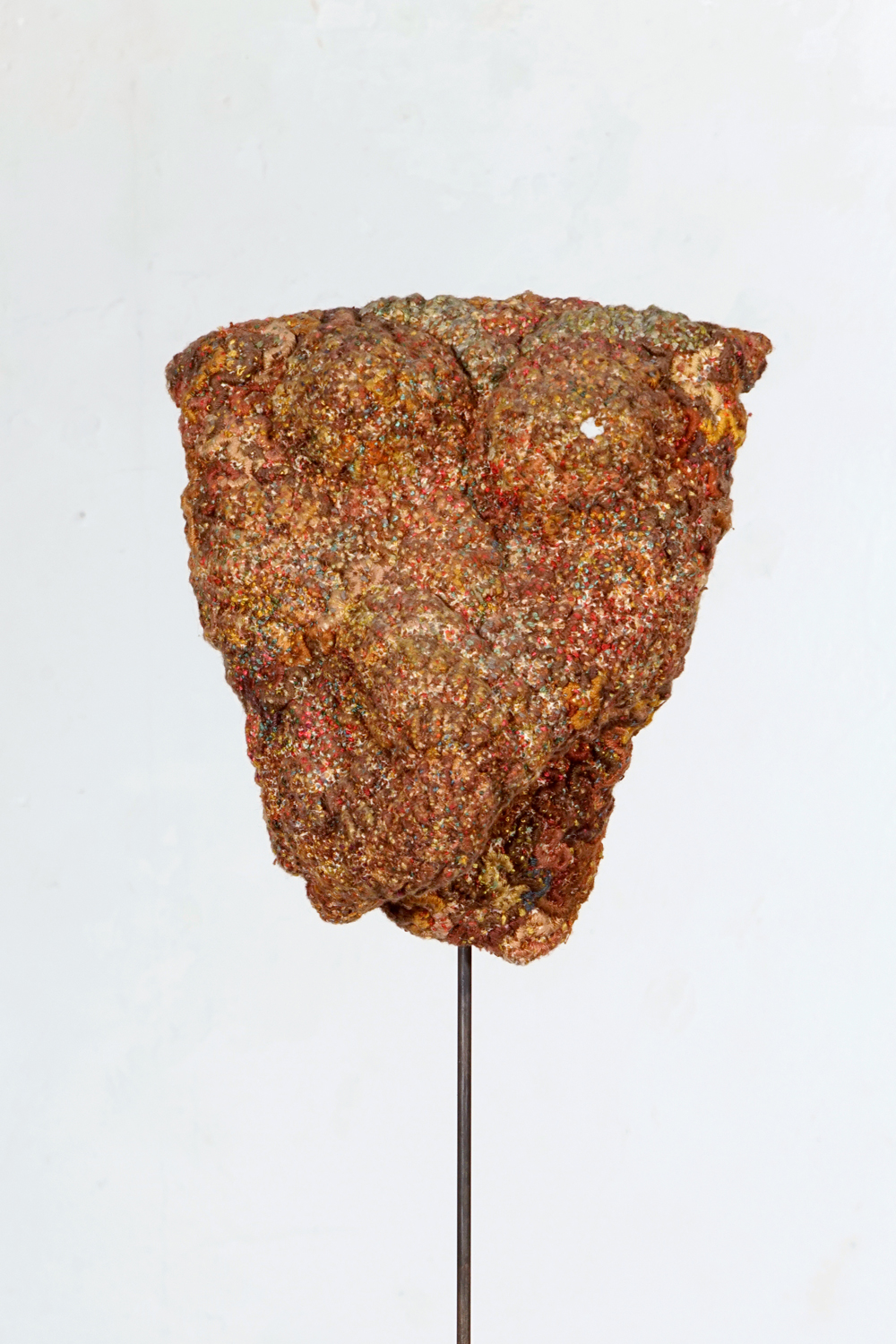
Unnamed 2015-2
2015年
糸、布、鉄、石 | Thread, Cloth, Iron, Stone
17 × 15 × 12 cm (スタンド含む高さ:145cm)
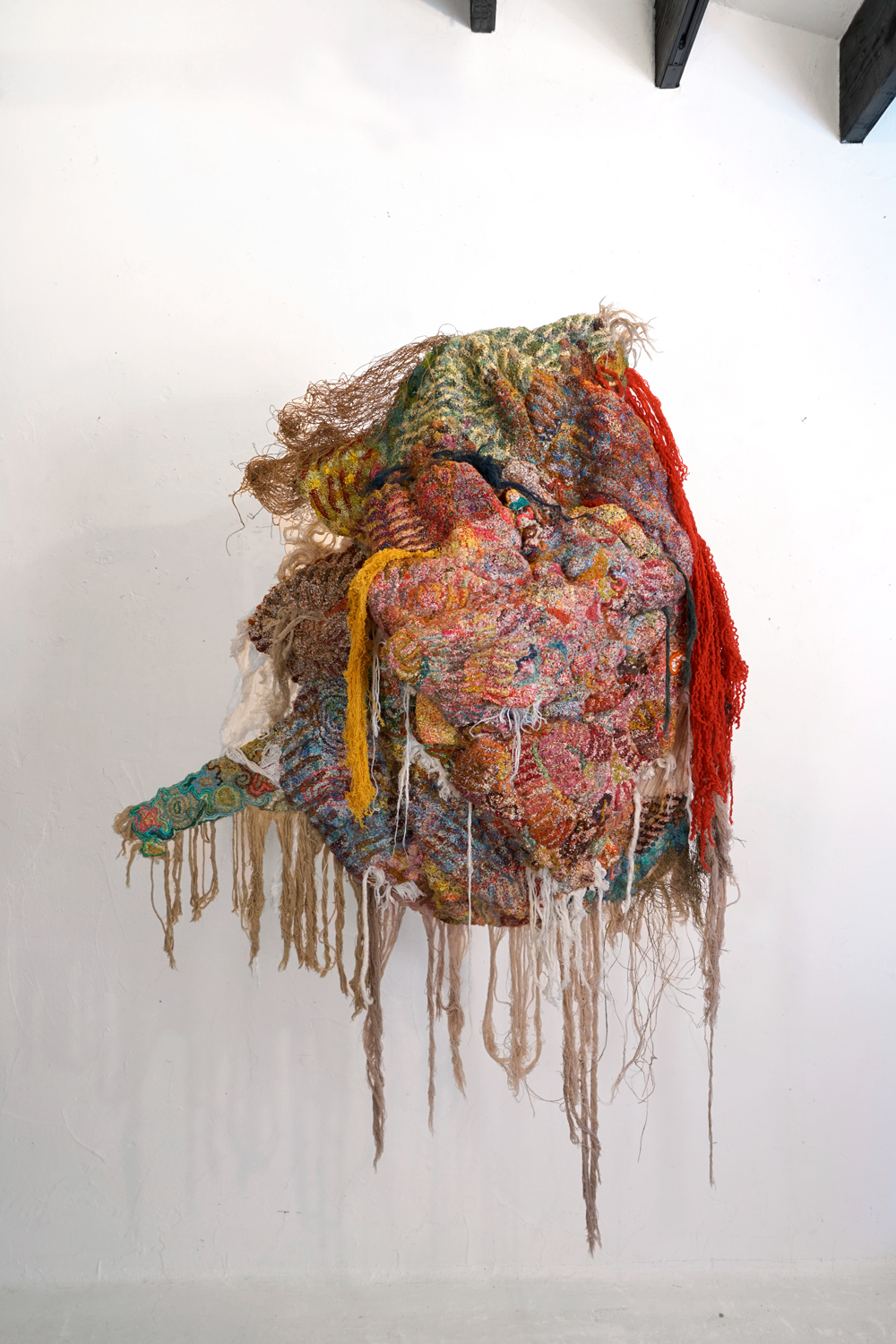
山思朗 San-Shi-Ro
2024年
糸、布、針金 | Thread, Cloth, Wire
120 × 85 × 48 cm(可変 | variable)
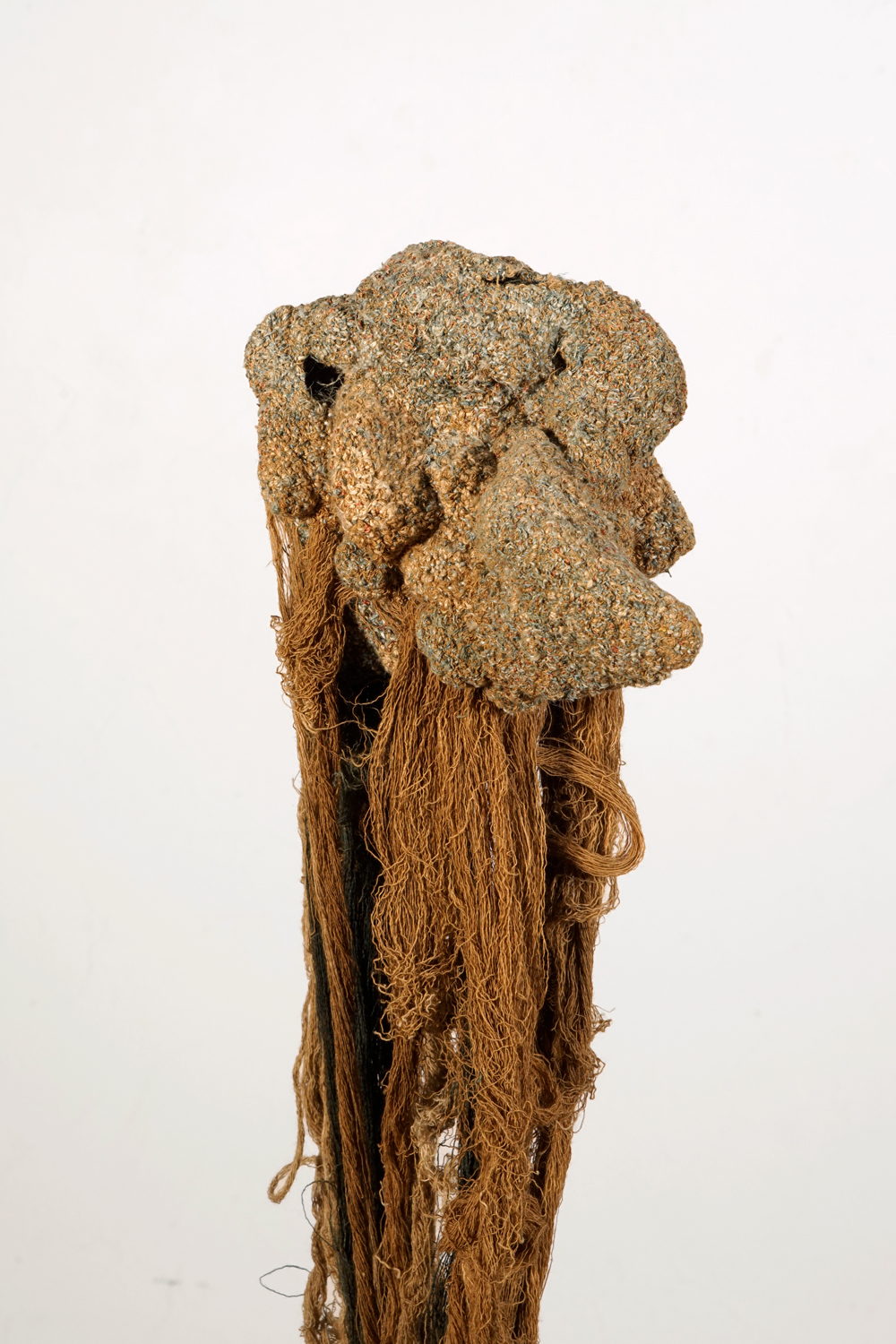
Unnamed 2017-1
2017年
糸、布、鉄 | Thread, Cloth, Iron
59 × 17 × 14 cm(スタンド含む | stand included)
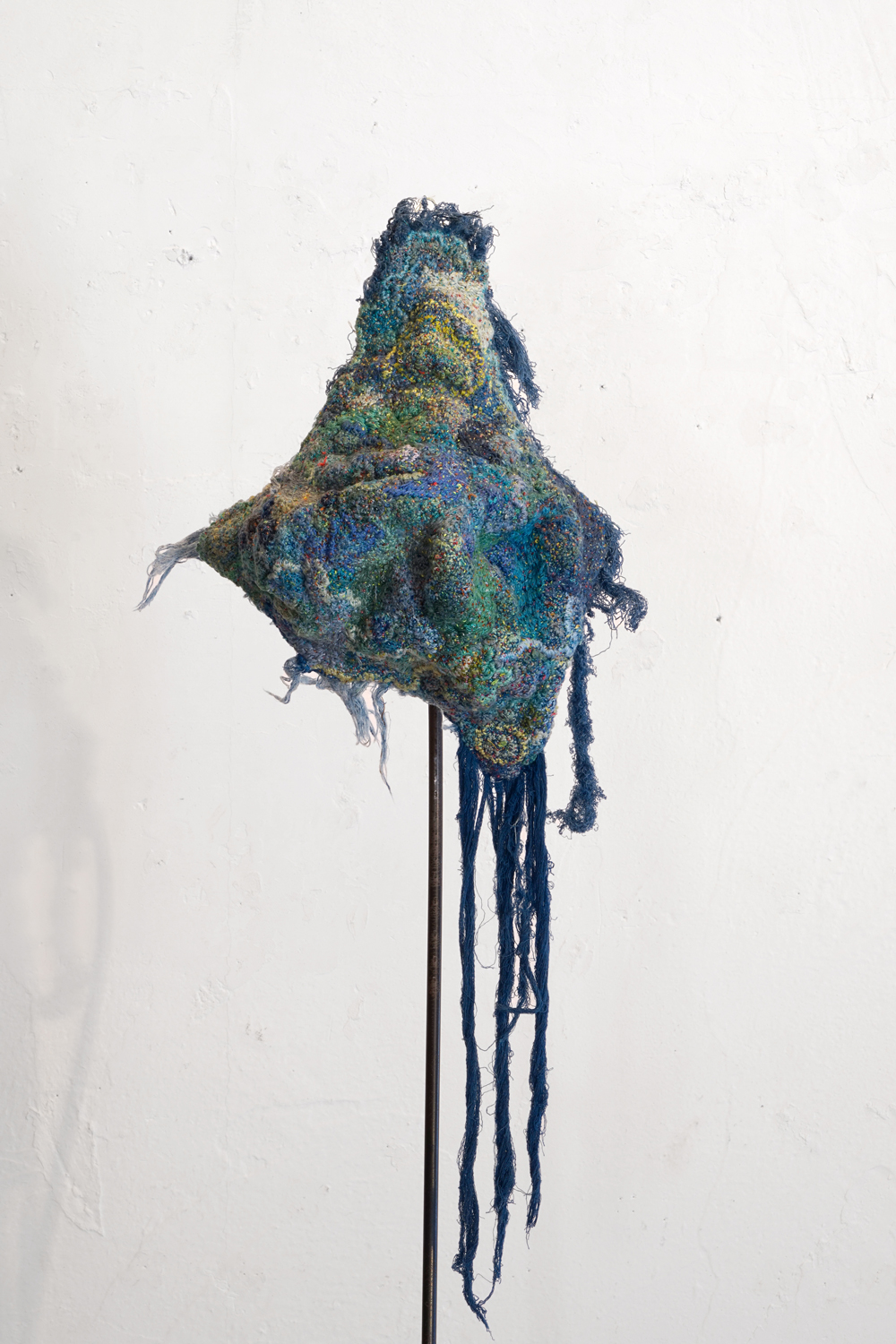
ぱらいそ Paraiso
2023年
糸、布、鉄、石 | Thread, Cloth, Iron, Stone
56 × 20 × 30 cm(スタンド含む高さ167cm)
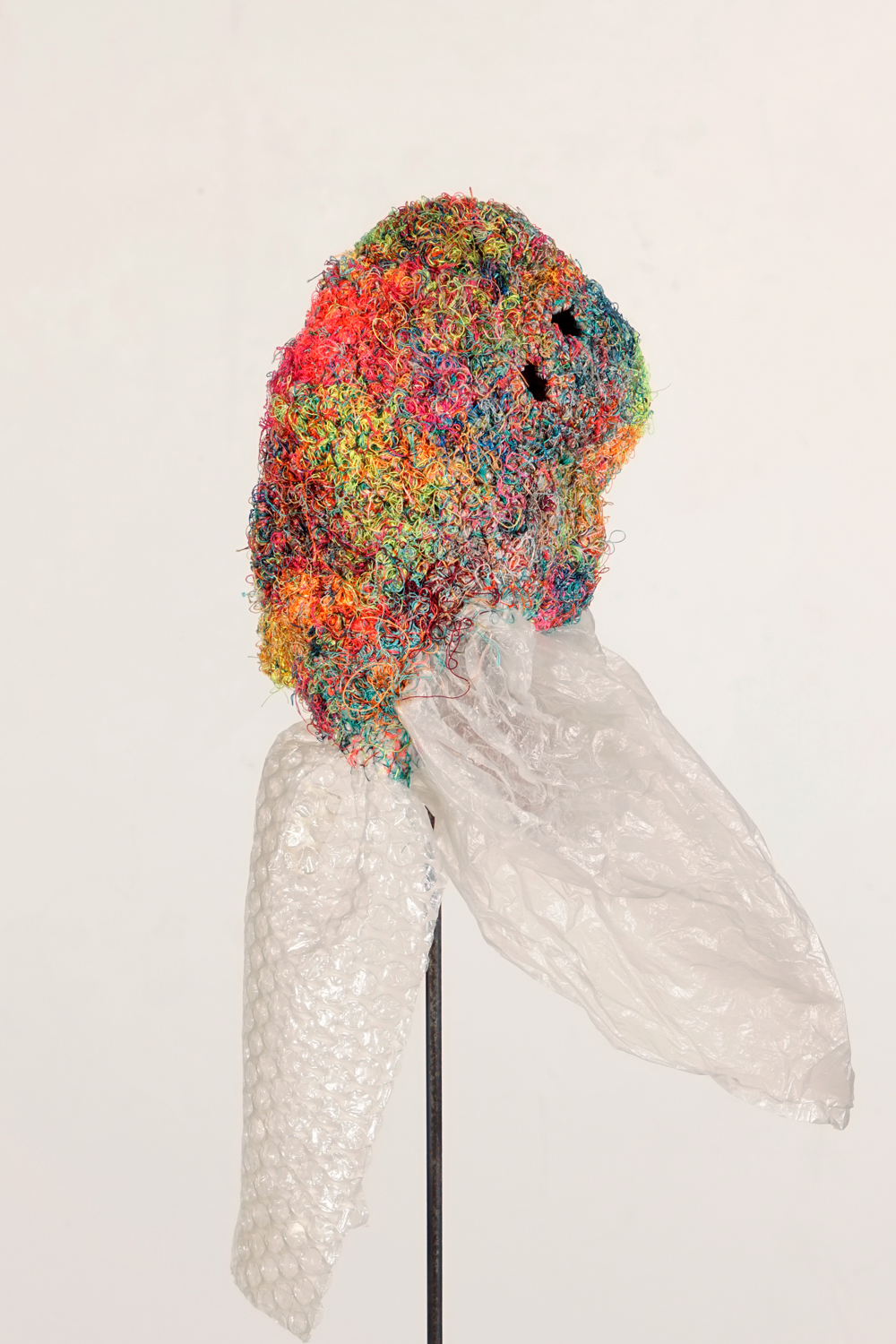
右3
2022年
糸、ビニール、鉄、石 | Thread, Plastic sheet, Iron, Stone
70 × 20 × 20 cm(スタンド含む | stand included)
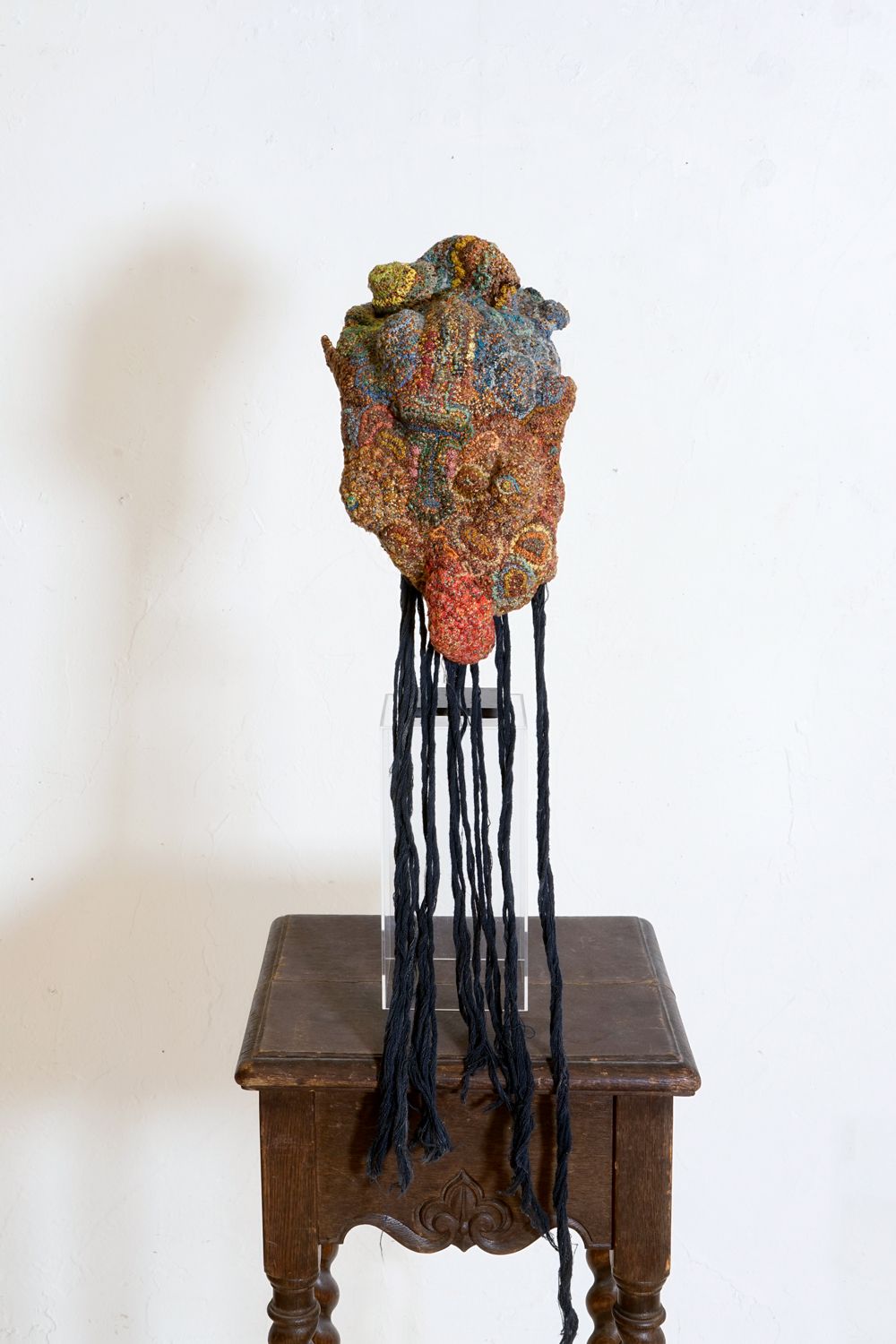
Unnamed (2016-2)
2016年
糸、布、鉄 | Thread, Cloth, Iron
80 × 16.5 cm(スタンド含む | stand included)
個人蔵(参考出品)Private Collection
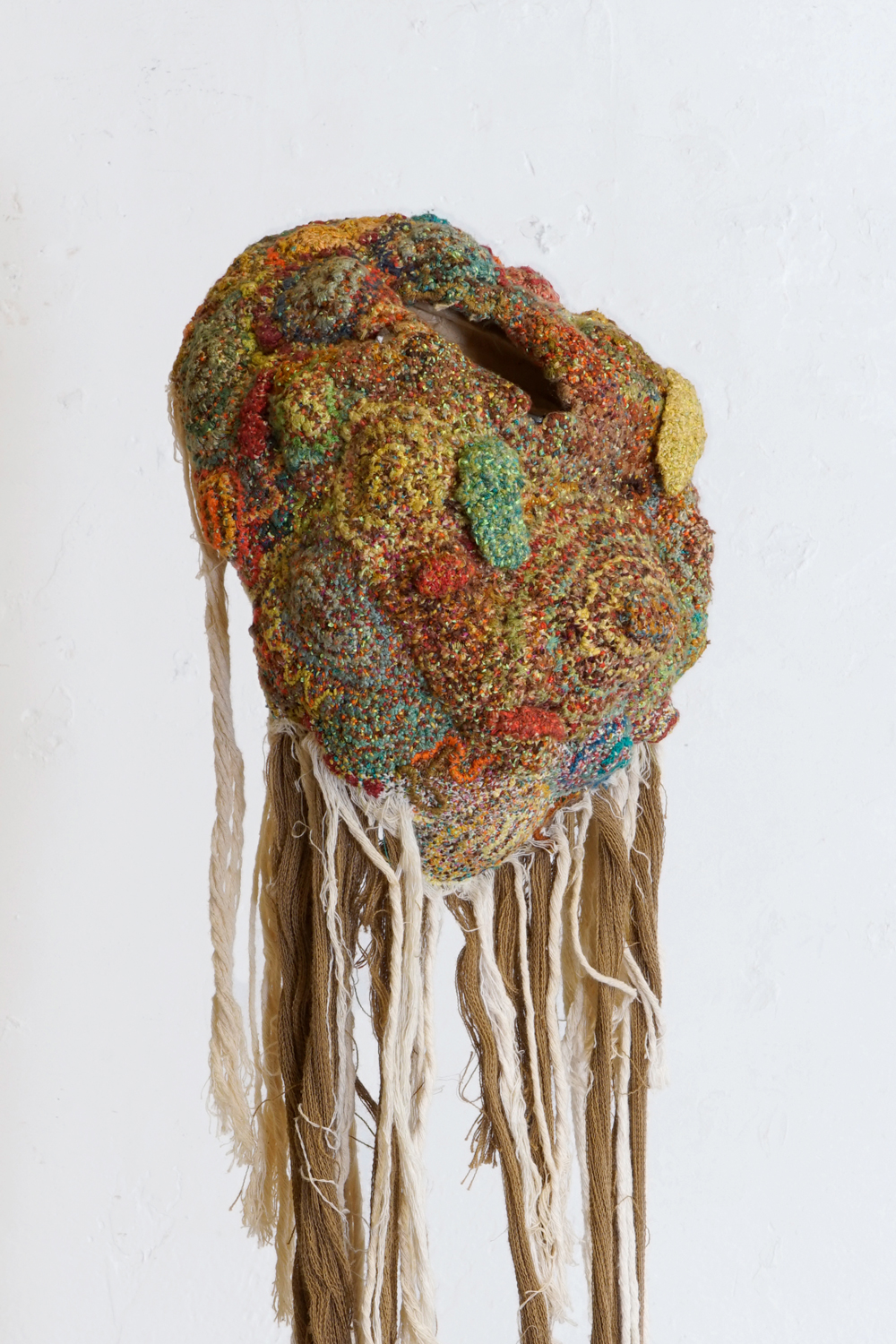
Unnamed (2017-2)
2017年
糸、布、紙、鉄 | Thread, Cloth, Paper, Iron
62 × 15 × 20 cm(スタンド含む | stand included)
個人蔵(参考出品) Private Collection
Any Which Way
Knowing when a work of art is complete is often a delicate question for artists, but in the case of Fusegi Yohei’s tidal composition Oku this sense of an ending has never applied. During the past decade over which Oku has been taking shape, various incarnations of this monumental textile have been exhibited. However, no single installation can lay claim to revealing the piece in its definitive or conclusive form. Instead, the fabric exists in a state of metamorphosis, materialising intermittently as it continues to pass through Fusegi’s hands.
Unpicking the varied interplay of methods which Fusegi’s practice draws upon is as complex as trying to set temporal or spatial parameters around his artworks’ progression. His pieces are the product of a number of techniques including embroidery, appliqué, and weaving, but he also recognises the role of less intentional forces such as weathering and gravity in the textiles’ formation. Sheaves of cloth coalesce around his home in Tokyo, taking on the colour of threads he picks out each day to reflect his state of mind. Fusegi also incorporates less conventional textures from other materials which come to hand, including paper, cardboard and plastic. In parallel with the work’s constructive processes, Fusegi must deconstruct these elements to render them susceptible to his needle before they can be recast within the larger mosaic of his compositions.
Rather than developing along a linear vector common to many weaving traditions, Fusegi’s interpolation of fragments feels both intuitive and organic. His pieces possess no fixed centre or even a designated frontal surface. Instead, as new accumulations of material are incorporated they shift the balance of patterns and generate warps in the fabric, setting in motion tensile ripples as well as visual resonances that echo throughout the body of the work. This model of growth might be compared to that of rhizomes such as coral, which extend in a distributed and multidimensional network rather than growing upwards from a central root.
Whilst many textiles are the product of calculated designs through which the artist’s vision is projected onto a static structure, Fusegi’s work brings to mind the cumulative maturation of natural phenomena, like the formation of geological strata or the layered construction of nests by birds and insects. He has embraced an open-ended and unselfconscious approach to creativity that defies the logic of rigid post-industrial production cycles with their blueprints and deadlines.
The fabric that emerges out of Fusegi’s practice reflects a diverse complexity, arising out of its gradual accrual over time. This evolutionary quality has been a source of inspiration for admirers of the natural world for millennia, and it is in this context that his work’s timeless appeal makes most sense. From sculptural forms the size of fruits or fossils to expansive swathes that cascade across walls, Fusegi’s patterns are kaleidoscopic in scale. They evoke the depth of starry constellations and the fluid, delicate spread of lichens, slime molds and fungi. Clusters of stitches and swells of colour tumble across the contours of the work’s many surfaces, appearing as if through a microscope or telescope. The work’s equivocal invocation of scale and distance encourages an alternative perspective, bringing us to a new appreciation of these materials and techniques which are so often identified with domestically oriented craft practices.
Perhaps this division between natural and domestic environments is another example of a binary distinction such as ‘East’ and ‘West’ or ‘art’ and ‘craft’ that simply does not serve Fusegi. His pieces are deeply embedded in his home, where he comes across materials, works them into fragments, and allows them to lie fallow until they find their place in larger compositions through his free hand and magpie eye. Fusegi has described these processes as being essentially integrated within the patterns of his domestic life; he works casually as he eats and has even used works in progress to wipe down the floors. After all, Fusegi’s home is his habitat, with this environment regulating the people and objects that dwell within it as naturally as the forest or the sea floor shapes its constituent forms of life.
Ecology has become something of a buzzword in the art world today, with destruction in the natural world prompting greater consciousness of environmental responsibility and a desire to explore the delicate systems that engender and support life on earth as we have known it. Urgent voices in politics and activism have embraced the concept as a means by which to question the perspective from which people have long privileged an understanding of the planet as the domain of human civilisation. However, there is another sense of ecology that is often lost in the heat of contemporary discourse, obscured by the clamour of conflicting worldviews and rival agendas.
Instead, in Fusegi’s work we are presented with a microcosmic illustration of ecological functioning. The fibres come together in a fluctuating matrix to form a single body, and perhaps in time will diverge into new constellations. Their dense interrelation traces the narrative of Fusegi’s quotidian work and care. There is an unruly authenticity to Fusegi’s unboundaried negotiation of his materials, which emerges incrementally in tune with the rhythms of his days at home. He explores the composition and properties of each strand beyond the everyday usages in which their forms as manufactured objects was originally determined.
The aggregated, amorphous nature of Fusegi’s fabrics testify to a holistic sense of time and space, so often incompatible with the fierce pace and regimented schedules of modern life in urban society. They speak to an alternative awareness of nature’s entangled reality, intimately bound up in a matrix of human and non-human timeframes and ultimately inextricable from the hectic flux of our own lives. Fusegi’s creative practice as well as his artworks may be read as an ecological parable through which we can reimagine our individual roles within this living tapestry.
Lucy Fleming-Brown
Director, Michael Hoppen Gallery, London
芸術作品が完成したという感覚は芸術家にとってしばしば微妙な問題であるが、伏木庸平の、断続的な構成を成す「オク」の場合、終わりという感覚は当てはまらない。「オク」が形作られてきたこの十数年において、この記念碑的なテキスタイルはさまざまな姿で展示されてきた。しかし、どのインスタレーションにおいても、その決定的な、あるいは帰結的な形を明らかにすることはできない。それどころか、布は伏木の手をくぐりぬけながら、折に触れて姿を変え続け、変容の中に存在している。
伏木の実践が引き寄せる多様な手法の相互作用を解明することは、作品の進行に時間的、空間的なパラメーターを設定しようとするのと同じくらい複雑である。彼の作品は、刺繍、アップリケ、織物など数多くの技法の産物であるが、テキスタイルの形成には風化や重力など、あまり意図的でない力の役割も認識している。東京の自宅にある布の束から、彼の心境を反映するように毎日糸が選ばれる。伏木はまた、紙、厚紙、プラスチックなど、手近にある他の素材から、従来とは異なるテクスチャーも取り入れている。作品の構成過程と並行して、伏木はこれらの要素を分解し、彼の針の影響を受けやすい状態にしてから、作品の大きなモザイクの中に再構成しなければならない。
多くの織物の伝統に共通する直線的なベクトルに沿って展開するのではなく、伏木のはぎれの補間は直感的で有機的な感じである。彼の作品には、固定された中心や、指定された正面すらない。その代わり、新たな素材の集積が組み込まれるにつれて、模様のバランスが変化し、生地にゆがみが生じ、引っ張られるような波紋と視覚的な共鳴が作品全体に響き渡る。この成長のモデルは、珊瑚のような根茎に例えられるかもしれない。根茎は、中心の根から上に向かって成長するのではなく、分散した多次元的なネットワークで伸びていく。
多くのテキスタイルが、アーティストのヴィジョンを静的な構造物に投影した、計算されたデザインの産物であるのに対して、伏木の作品は、地層の形成や鳥や昆虫が巣を何層にも重ねるといった自然現象の累積的な成熟を思い起こさせる。彼は、設計図や納期がある産業革命後の硬直した生産サイクルの論理に逆らう、制限のない無自覚な創作へのアプローチを受け入れている。
伏木の実践から生み出される布地は、時間をかけて徐々に積み重ねられた多様な複雑性を反映している。この進化的な性質は、何千年もの間、自然界を愛する人々のインスピレーションの源であり、彼の作品が時代を超越した魅力を持つのは、このような背景があるからである。果実や化石ほどの大きさの彫刻的な形から、壁一面に流れ落ちる広大な広がりまで、伏木のパターンは万華鏡のようなスケールだ。それらは星座の奥行きや、苔類や粘菌、菌類の流動的で繊細な広がりを思わせる。ステッチの鈴なりや色のうねりは、作品の表面の輪郭を横切り、まるで顕微鏡や望遠鏡を通しているかのように見える。作品のスケールと距離感を曖昧にすることで、別の視点が生まれ、家庭的工芸と定義されがちなこれらの素材と技法に対する新たな評価が生まれる。
自然環境と家庭環境という区分もまた、「東洋」と「西洋」、あるいは「芸術」と「工芸」といった二元的な区別の一例であり、伏木にとっては単純に通用しないものであろう。彼の作品は彼の家に深く埋もれ、そこで素材に出会い、それらをはぎれに加工し、彼の自由な手とコレクターの視点を通して、より大きな作品に居場所を見つけるまでそこで眠るのである。伏木は、これらのプロセスは基本的に彼の家庭生活のパターンの中に統合されていると述べている。彼は食事をしながら何気なく仕事をし、進行中の作品を使って床を拭いたこともある。結局のところ、伏木の家が彼の生息地であり、その環境は、森や海底がその構成要素である生命体を形成するのと同じように、そこに住む人々や物体に自然と影響しているのである。
自然界の破壊が進むにつれ、環境に対する責任意識が高まり、私たちが知っているような地球上の生命を生み出し支えている繊細なシステムを探求したいという欲求が高まることで、エコロジーという言葉は今日、アートの世界でも流行語のようになっている。政治や活動家たちの切実な声は、地球を人類文明の領域として理解することを人々が長い間特権としてきた視点に疑問を投げかける手段として、この概念を受け入れてきた。しかし、エコロジーにはもうひとつ別の意味がある。それは、対立する世界観や対立するアジェンダの喧騒によって、現代の言説の熱気の中で見失われがちである。
一方で、伏木の作品では、生態系の機能を小宇宙的に表現している。繊維は変動するマトリックスの中で集まってひとつの形を形成し、やがて新たな星座へと分岐していくのだろう。その濃密な相関関係は、伏木の日常的な仕事と心遣いの物語をなぞっている。伏木の素材に対する境界のない交渉には、無秩序な信憑性があり、それは彼の家での日々のリズムに調和して少しずつ現れてくる。彼は、製造物としての形が元々決まっていた日常的な用途を超えて、それぞれの繊維の構成と特性を探求している。
伏木の布の集合的で不定形な性質は、現代社会における生活の激しいペースや規則正しいスケジュールとはしばしば相容れない、全体的な時間と空間の感覚を物語っている。それらは、人間と人間以外の時間軸のマトリックスに密接に結び付き、究極的には私たち自身の生活の目まぐるしい流れとは切り離すことのできない、複雑に絡み合った自然の現実に対するオルタナティブな意識に語りかける。伏木の創作活動や作品は、私たちがこの生きたタペストリーの中で個々の役割を捉え直すことができる、生態系の寓話として読むことができるだろう。
Lucy Fleming-Brown
Director, Michael Hoppen Gallery, London
伏木庸平の針仕事 - INNER LIGHT
子供だった頃、ふと、目が覚めた深夜の寝床の深い闇や、眠れぬ夜の火照った瞼のスクリーンに七色の虹彩に輝く小さなモザイクを見たのは、私だけだろうか。小さく見えていた無数の色の点はやがて大きく渦巻きながら輝きを増し、色彩の迷宮となって、私を恍惚とさせた。あの、モザイクはなんだったのだろう。暗闇でオーロラを待つように目を凝らしていると、やがて、あの、渦が出現し部屋いっぱいに広がって、元の暗闇を覆い尽くす。そんな、子供の頃の、夢とも恐れともつかぬ思い出を伏木さんの作品を見ているうちに思い出す。太古の時代より人々は夜空に輝く満天の星辰やオーロラなどの大スペクタルを飽きることなく見上げていたはずだ。私たちの中にはその記憶が強く染みついている。美の世界に見ると、古くは装飾古墳の石室内や平安時代の平家納経の装飾経の金銀砂子やキリスト教のモザイクイコンなどが、すぐ思い浮かぶ。近現代ではグスタフ=クリムトの「抱擁」に代表されるような作品群や1960年代の瑛九の作品などが思い起こされる。今現在、伏木さんの作品を皆さんと共有できることはどんな意味を私たちに与えてくれるのだろうか。世界の人々の心から夢色の破片が剥ぎ取られ黒色に塗り替えられて行きそうな予感が充満しつつある今、伏木さんの一針一針の祈りが私たちの未来を守ってくれることを期待したい。
人間も虫や魚や粘菌類も同じように自分の存在を誇張し伴侶を求めます。又、産みだされた子孫たちは美しい産着で包まれます。永遠に繰り返されるこのような営みは伏木さんの声明の鼓動とシンクロして私たちを魅了します。
兒嶋俊郎 (兒嶋画廊)
Yohei Fusegi’s Needlework
Is it just me, or was there anyone else who, as a child, noticed a tiny, seven-colored mosaic shining in the deep darkness when I suddenly woke up or on the screen behind my tired eyelids on a sleepless night?
The numerous dots of color that had seemed so small soon swirled together to form a labyrinth of colors that made me fall into a trance.
I wonder what that mosaic was.
Waiting for an aurora in the darkness I was gazing, and whirlpool would appear and spreading across the room and cover the darkness.
Fusegi’s works remind me of something from my childhood, which could be a dream or a nightmare.
Since prehistoric times, people must have never tired of looking up at the great spectacles in the night sky, such as the starry heavens and the aurora borealis.
The memory of these events must be strongly ingrained in our minds.
In the art world, the ancient interior of the stone chamber in a decorative burial mound, the gold and silver sands of a decorative sutra “Heike Nokyo”of a Heian-period, or the mosaic icons of Christianity come immediately to my mind.
In modern times, it would be artworks such as Gustav Klimt’s “Fulfilment” and Eikyuu’s works from the 1960s.
What significance does it give us to share Fusegi’s works with you today?
At a time when people around the world are being stripped of their dreams and painted black, we hope that Fusegi’s prayers, stitch by stitch, will protect our future.
Humans, insects, fish, and slime molds wrap their offspring in the same beautiful maternity clothes. The needle and thread move back and forth, at the same pace as the insects and other living creatures.
Toshio Kojima (Gallery Kojima)

